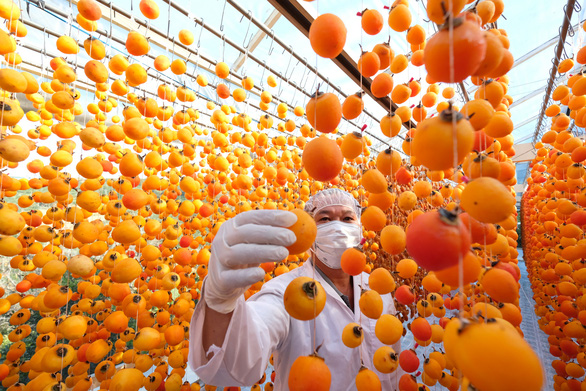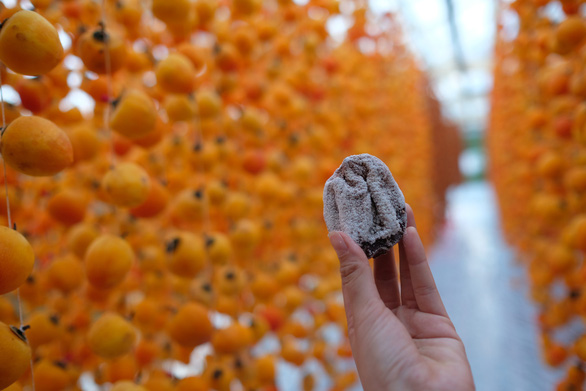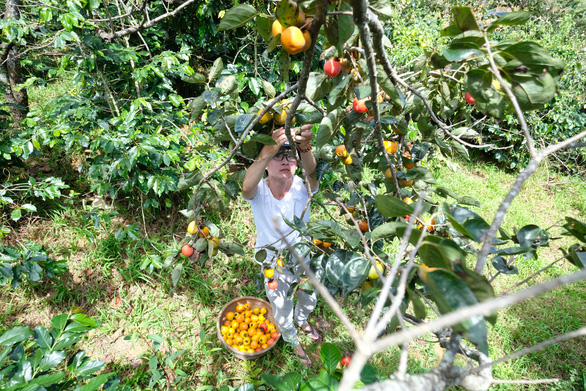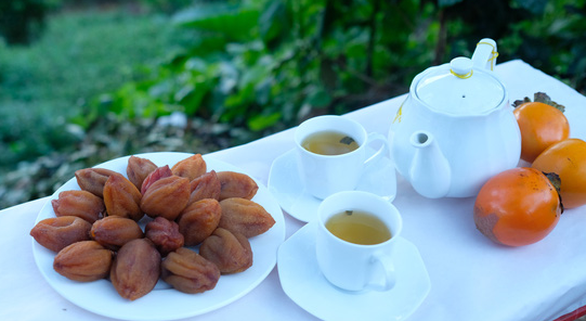In the late 190s and early 1990s, several years before the Central Highlands city of Da Lat became one of Vietnam’s biggest tourism draws, nearly every local household in the city proudly grew persimmon trees.
Though barely taken care of by locals, the persimmon trees still manage to bear fruit each autumn, adding a tinge of orange to the hilly town’s rustic charm.
About 30 or 40 years ago, Da Lat’s persimmon trees, neatly grown in front of newly built households, were one of the first things to catch visitors’ eyes.
For locals, the trees not only added a pop of color to their gardens, but also provided shade and delicious fruits.
“Persimmon trees were a cultural entity that shaped the lifestyle of Da Lat residents,” said Nguyen Huu Tranh, author of 'Da Lat Nam Xua (Old Times of Da Lat),' a quintessential study of the highland city.
It takes nearly a decade for a persimmon tree to mature, yet persimmons themselves are sold for a mere VND5,000-10,000 (US$0.21-43) per kilogram.
With each tree only capable of producing up to 100 kilograms per year, it is obvious most locals grew persimmons out of love for the fruit rather than financial return.
|
|
| A piece of hoshigaki (sun-dried persimmon). Photo: Mai Vinh / Tuoi Tre |
“The food culture, gardening culture, and the whole manneristic lifestyle of Da Lat people are essentialized in this variety of tree,” Tranh said.
An ode to the fruit
Dang Thi Thu Van, owner of a specialty persimmon shop on Le Van Street in Da Lat, has managed to earn a living off producing ‘crunchy’ persimmon – a version of the fruit that is cured to remove its unbearably acrid taste.
Van’s curing process is relatively straightforward.
She picks the fruit when it turns light yellow and leaves it in an air-tight bag for five days to break down its tannins -- the astringent organic compounds abundant in fresh-off-the-twig persimmon. These five days also give the persimmon time to ripen a bit more and achieve a crunchy texture.
According to Van, persimmons left to fully ripen on the tree, as well as picked half-ripe persimmons that have been left in aerated spaces, develop a soft, custardy mouthfeel, yellow pericarp, and a sweet, juicy flavor.
On top of that, the skin of the fruit turns a vivid shade of pink, hence its Vietnamese name 'trai hong' or 'pink fruit.'
Van shared that growing up she often resorted to fully ripe persimmons during times when food was scarce.
In Da Lat, persimmon harvest seasons begin in mid-September and end in late November or early December, just as the city’s rainy season is ending.
During this time, farms in Da Lat spend a great deal of time making dried persimmons by sun-drying pieces of the fruit before fully dehydrating them in a charcoal oven.
Each batch takes approximately five days to make.
During Tet holiday – the Vietnamese Lunar New Year celebration – families in Da Lat often gather and tell stories over plates of dried persimmons and warm cups of tea.
|
|
| A farmer collects persimmons in Da Lat City. Photo: Mai Vinh / Tuoi Tre |
Van’s children, who left their town to work in finance and banking, have all come back to take on the family business.
Van and her daughter Lan Anh dry their persimmons at a processing facility deep inside a persimmon plantation in Da Lat’s Khe Sanh Valley.
The fact that she has not sold the land despite the current local real estate boom coupled with the low profitability of persimmons is an ode to her appreciation for the fruit.
The duo disapproves of the ‘industrialized’ way of dehydrating persimmons by using honeycomb charcoal as fuel in order to decrease the amount of time it takes to produce a batch, claiming that using wood charcoal and hot air produces a final product that is more tender and chewy.
The taste of fall
Da Lat persimmons saw a breakthrough about eight years ago when an initiative undertaken by the Japan International Cooperation Agency (JICA) introduced a group of 100 local farmers to the traditional Japanese approach to aging the fruits using only natural sunlight and wind.
|
|
| A plate of dried persimmons is served alongside tea. Photo: Mai Vinh / Tuoi Tre |
The end product, known as ‘Hoshigaki,' saw its first commercial batch released in Da Lat six years ago. Due to its eye-catching finish, Hoshigaki can sell for up to four times the price of typical dried persimmons.
Mai Xuan Long, head of the Dat Lang Cooperative in Da Lat, sees the introduction of Hoshigaki to the market as a breath of life for the city’s vast persimmon tree population and the dried persimmon industry.
According to Long, fresh persimmons used to sell for only VND2,000 ($0,08) per kilogram with supply far exceeding market demand while the dried variety carries no unique flavor, made only for a longer shelf life.
Now, as Hoshigaki takes hold of the market, the price of fresh persimmons has increased 500 percent to VND10,000 ($0.43) per kilogram.
As a result, Long has begun add about 80 persimmon trees to each hectare of his coffee plantation. The trees, which benefit from the excess fertilizer used for coffee farming, provide him with an extra VND100 million ($4,313) per season.
Currently, about 370 hectares of farmland in Da Lat is dedicated to persimmon cultivation.
In total, the city produces over 12,500 tons of produce per year, according to the Da Lat economy bureau. Now, as Hoshigaki grows in popularity, the city’s persimmon supply is struggling to keep up with demand.
According to Long, one of the Vietnamese farmers who participated in the JICA initiative, the persimmons used for Hoshigaki should be the ones that ripened just halfway through. The fruit should then be washed and carefully peeled with the stem left intact.
Next, the persimmons must be briefly put through a wood charcoal oven so that outer layers begin to shrink.
They are then put into a dehydration room with two-layer doors and air blowers to prevent dust and pests from entering.
Throughout the process, the fruit must be massaged in order to ensure its sweetness. The entire process takes 25 days.
|
|
| A piece of ageing persimmon. Photo: Mai Vinh / Tuoi Tre |
“I have to wear gloves and massage each piece every day. It’s extremely time-consuming but critical to ensuring the quality of the Hoshigaki,” Long said.
“You can tell how fresh the persimmon was just by looking at its dried piece. When split in half, [pieces of Hoshigaki] reveal thick, sweet syrup inside – the essence of the persimmon’s flavor lies in there."
Hoshigaki can be stored in a freezer and then be eaten easily without defrosting as it does not freeze.
In fact, the delicacy continues to age after staying in the freezer for a year or more, resembling Japan’s cold treatment approach using winter snow.
Cold treatment causes sugar from each piece to coagulate on its skin – a sign of excellence that can further elevate the market price of the product.
For the immense work, rigor, and thought that go into producing Hoshigaki, it is not at all hyperbolic to call each piece of persimmon a fine work of Da Lat’s culinary artistry.
It is the taste of the Da Lat autumn, crystalized in a bite-sized piece.
Like us on Facebook or follow us on Twitter to get the latest news about Vietnam!

















































